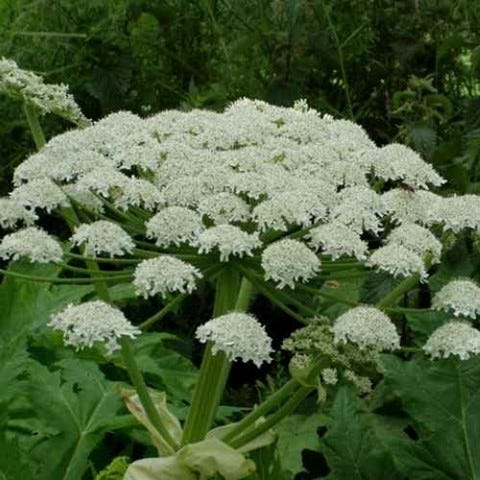The plant that 'BURNS' you
& the 27th letter in English language
(Trigger Warning: Contains graphic images that may be disturbing)
Hi guys! How you doin’? Hope you have cured your weekend hangover by now, ‘cause we need your FULL ATTENTION!!
THIS IS A PSA. So, we’re diving right into it (please do not ignore this!)
Will you believe us if we say the burns caused in the above pictures 👆 were caused by a plant? Bizarre, right?
But, the scariest part is that the plant in question is so common that probably it’s growing in your BACKYARD right now!
We are talking about the Giant Hogweed, a seemingly innocent-looking plant with tall stalks and white flowers that has now become one of the most dangerous invasive species in the US! Particularly prevalent in New York state, this plant poses severe health risks to anyone who comes into contact with it (just as shown in the pics).So, where did it come from?
Giant Hogweed (Heracleum mantegazzianum) is an invasive plant originally brought to the US from the Caucasus Mountains in Russia and Eurasia over two centuries ago. While it may look attractive, it is packed with noxious sap that can cause severe skin reactions and long-term health issues.
This sap causes phytophotodermatitis, a condition that stops the skin from protecting itself against the sun’s harmful ultraviolet rays. Exposure to it can result in:
Severe burns and blistering
Painful pustules
Long-lasting scars
Blindness in extreme cases
Real-life Example: Patryck Jones, an assistant pastor in Syracuse, encountered the perils of Giant Hogweed while clearing brush around his church. Unaware of its presence, he came into contact with the plant, and within 30 minutes, experienced severe itching and burning on his skin. This quickly escalated into intense blisters and open sores. Despite receiving medical treatment, it took a full month for his rash to heal, leaving him with permanent scars.How to identify Giant Hogweed?
Height: Can grow up to 14 feet tall.
Stems: Hollow, with dark red or purple spots and bristles.
Leaves: Large, deeply lobed, and sharply pointed.
Flowers: White, umbrella-shaped clusters that can be up to 2.5 feet in diameter.
Where is it Found?
Giant Hogweed is especially prevalent in New York state. Nearly 1,150 active sites have been reported, with infestations present in 53 out of 62 counties. Garden centers unknowingly sold the plant in the early 1900s, leading to its widespread distribution.
What to do if you encounter Giant Hogweed?
📌 Do Not Touch: Avoid direct contact with the plant. Do not cut it down or handle it without proper protection.
📌 Report It: If you think you’ve found Giant Hogweed, report it to the New York Department of Environmental Conservation (DEC) or local authorities.
📌 Seek Medical Attention: If you come into contact with the sap, wash the area immediately with soap and water, avoid sun exposure, and seek medical help.
The 27th Letter in the English language
Did you know the alphabet used to have 27 letters? Yep, right after 'Z' came the ampersand (&)! TikTok's Zack (@zachdfilms3) revealed this quirky fact, explaining how kids would recite "and per se and," which evolved into "ampersand."
Even the Bodleian Libraries at Oxford backed this up 👇
The ampersand, a fancy combo of 'E' and 'T' from Latin, first popped up in Pompeii graffiti. While it's no longer part of the alphabet, designers still love using it.
BTW, English also ditched other cool letters like thorn (þ) and wynn (ƿ) as printing tech advanced. So, next time you see an &, remember its quirky past as the 27th letter!
So, that’s it for today. Let’s meet again tomorrow 👋 Till then, stay curious, and stay away from suspicious plants!






Most interesting newsletter ever read! ❤